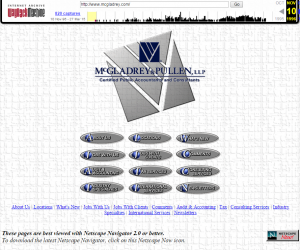If you were a business joining the small list of 100,000 websites that existed in 1996, you would not have only had to look at projecting the future growth of your company for the year, but you also would have had to try to envision the direction of the world wide web, it’s growth, and how your new site could be used to propel your company forward. During this time, forty percent of US households had access to a computer, and businesses were beginning to recognize that they no longer had the ability to just broadcast information to the public, they needed to be doing more. Though the connections through dial-up modems were slow and cumbersome, people’s expectations would be increasing full speed. E-commerce would become a necessity and businesses were seeing that their pages needed to have room for expansion and provide more options for their audience. It wouldn’t be for another 2 years until Google is born, but the internet was certainly on the rise. Trying to predict the future of what the internet would become was an exciting, but an overwhelming task to say the least.
RSM’s website 1996

RSM’s website 1996
RSM’s website 2015

I don’t believe that anyone in those days could have envisioned how engrained the internet and technology would become in our lives. Today, many households have not one, but multiple computers. We can walk down the street and view maps and take photos by just touching the rim of our glasses. Want to know where something is? Ask your car. Email is always tucked away in our pockets and even on our watches. Our children are raised knowing how to swipe a finger across a phone. Technology will always be expanding as we chase it-trying to predict its direction and growth. One of the best ways to stay in the forefront is to always be prepared for that expansion.
Knowing what the future has in store for us is almost completely impossible. Therefore, we must build an infrastructure that is both expandable and versatile. The most common way to do that these days is by decoupling the hardware from the software. This was first done by moving to virtualization. We implemented VMware ESXi and Microsoft Hyper-V hypervisor hosts to virtually lift up the operating systems so that they can be moved from one host to another without the need for scheduled (or not so scheduled) downtime. Recently, we have begun implementing virtual networking and virtual storage. Again, just like VMware and Hyper-V, we are virtually lifting up the logical presentation and management of data and separating that data from the physical hardware. This allows us to move a virtual switch from one physical medium to another or move a volume from one RAID Group to another without impacting the end users accessing that data while at the same time allowing us as IT professionals to expand and adapt the environment to the business as it changes.
NetApp has been a leader in expandable and versatile storage for years. Below is a short list of some of their more prevalent technologies that set them apart from much of their competition.
- Thin provisioning (over provisioning of both volumes and LUNs)
- Expandable raid groups and aggregates
- Expandable AND Shrinkable volumes
- Virtual networking – not just for standard networking but also for iSCSI and Fiber Channel
- Virtual Storage Servers
- NAS (NFS and CIFS/SMB)and SAN (iSCSI and Fiber Channel) protocols on the same physical hardware
- *NEW – Drive Partitioning
Business and the technology to support that business is a constant moving target. We as technology leaders must plan and develop solutions that can not only expand but also adapt to the needs of the organization. There are thousands of technologies available to assist with this endeavor. Designing a solution that has the ability to be versatile will be critical for the future success of your organization.
If you would like to hear more about what NetApp, VMware or Microsoft has to offer, please check out our website. You can also contact RSM’s technology consulting professionals at 800.274.3978 or email us.

 RSMUS.com
RSMUS.com